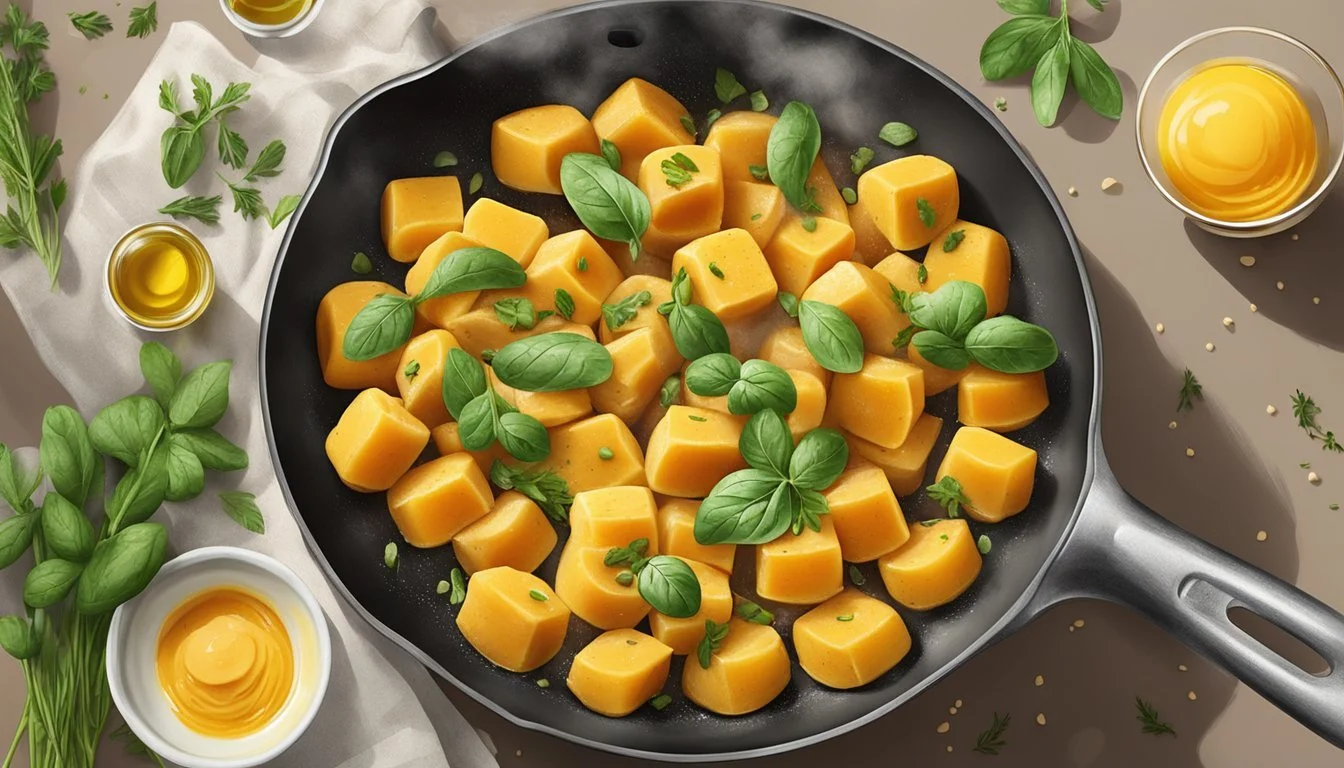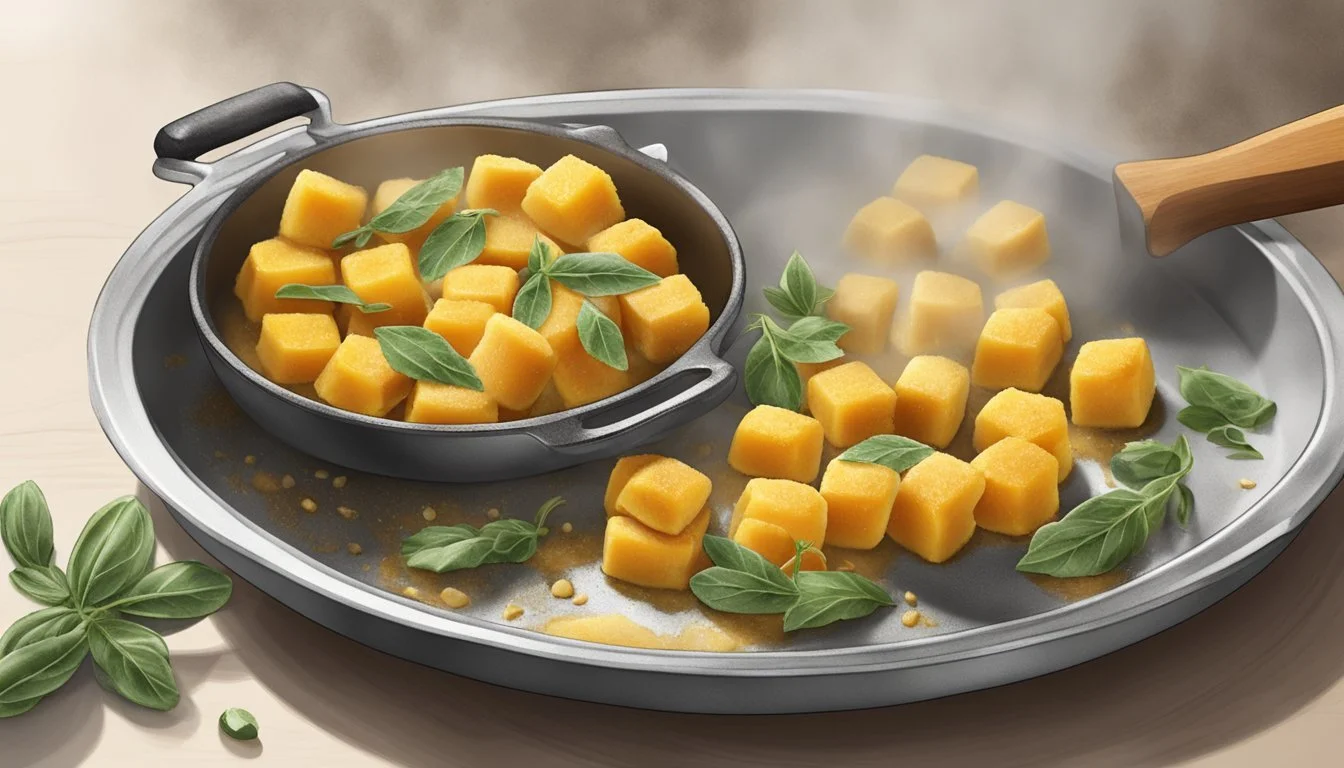How to Reheat Butternut Squash Gnocchi
Simple and Effective Techniques
Reheating butternut squash gnocchi can be a bit of an art, especially if you want to maintain that perfect texture and flavor. This comforting dish, loved for its tender, pillowy texture and rich flavor, deserves a reheating method that keeps those qualities intact. The best way to reheat butternut squash gnocchi is to use the stovetop method, which allows for precise temperature control and retention of moisture.
By using a skillet and adding a small amount of water or broth, you can gently introduce steam that prevents the gnocchi from drying out. This method not only warms the gnocchi evenly but also helps keep them soft and delicious, ensuring that the rich, hearty taste remains irresistible.
Alternatively, for those in a rush, the microwave offers a quick solution. Placing the gnocchi in a microwave-safe dish with a splash of water and covering it before heating can also yield satisfactory results. Be sure to heat in short intervals to avoid turning the gnocchi into a tough, rubbery mess. Whether you're looking to savor yesterday's leftovers or meal prepping for the week, these techniques ensure your butternut squash gnocchi remains a comforting delight.
Understanding Butternut Squash Gnocchi
Butternut squash gnocchi is a delightful variation of traditional Italian dumplings, combining the sweet, tender texture of roasted squash with the classic gnocchi dough for a unique culinary experience.
Defining Butternut Squash Gnocchi
Gnocchi: These are small, soft dough dumplings, typically made from potatoes, flour, and eggs.
Butternut Squash: When incorporated into the gnocchi dough, it replaces some or all of the potato, providing a subtle sweetness and vibrant color.
Homemade vs. Store-bought: Homemade butternut squash gnocchi allows for customization and fresh taste while store-bought offers convenience.
The dough is formed by kneading cooked and mashed butternut squash with flour and sometimes eggs, resulting in a smooth mixture that is rolled into ropes and cut into bite-sized pieces. These pieces are then boiled until they float to the surface, signaling they are cooked and tender.
The Appeal of Squash in Gnocchi
Flavor Profile: The butternut squash brings a natural sweetness that complements a variety of sauces, from rich butter sage sauces to light herb and garlic blends.
Texture: The tender nature of the squash adds a soft, melt-in-the-mouth quality to the gnocchi, making it ideally suited for achieving both crispy and delicate textures when prepared in different ways.
Nutritional Benefits: Butternut squash is rich in vitamins A and C, providing a nutritious twist to traditional gnocchi.
Versatility: Squash gnocchi pairs well with a range of ingredients. This makes it ideal for diverse recipes whether savory or sweet.
The presence of butternut squash in gnocchi not only enhances the flavor but also adds an element of nutritional value and culinary versatility. Both home cooks and professional chefs value this unique blend for its adaptability and distinctive taste.
Preparation Basics Before Reheating
To achieve the best results when reheating butternut squash gnocchi, it is crucial to start with properly cooked and stored gnocchi. Additionally, freezing and thawing techniques play a significant role in maintaining the texture and flavor.
Cooking and Storing Fresh Gnocchi
Cooking homemade butternut squash gnocchi begins with boiling water in a large pot. Salt the water generously to enhance the taste of the gnocchi. Gently add the gnocchi, cooking until they float to the surface, usually taking about 2-3 minutes. Use a slotted spoon to transfer them from the boiling water to a bowl.
Once cooked, drain the gnocchi well. If not serving immediately, it's important to cool them quickly to prevent them from becoming mushy. Spread the gnocchi on a baking sheet in a single layer, and refrigerate. This helps to maintain their texture. Store the gnocchi in an airtight container in the refrigerator for up to two days. For added flavor, toss with a bit of olive oil or butter before refrigerating.
Freezing and Thawing Techniques
Freezing butternut squash gnocchi is an excellent way to preserve leftovers. Arrange the cooked and drained gnocchi on a baking sheet ensuring they don't touch. Freeze them until solid, which takes around 2 hours. Transfer the frozen gnocchi to a freezer-safe bag or container, removing as much air as possible before sealing. Label the container with the date to keep track of storage time.
When ready to use, thaw the gnocchi correctly to maintain their texture and prevent them from becoming soggy. Transfer the frozen gnocchi to the refrigerator and let them thaw overnight. For quicker results, place the frozen gnocchi in a colander and dip it into boiling water for about 30-60 seconds. This method helps in reviving the original consistency.
By handling the gnocchi carefully during these preparation steps, the reheating process becomes simpler and more effective, allowing the gnocchi to retain their delightful texture and flavor.
Reheating Techniques for Optimal Taste
Reheating butternut squash gnocchi requires specific methods to maintain its soft texture and rich flavor. Each approach offers unique benefits and considerations, ensuring your gnocchi remains as delicious as when freshly made.
Using the Oven
Preheating the oven to 350°F (180°C) is the first step. Place the butternut squash gnocchi in an oven-proof dish and add any accompanying sauce. To prevent the gnocchi from drying out, sprinkle a tablespoon of water over the dish and cover it with foil. Heat for 10-15 minutes until the gnocchi is warmed through. This method is effective for sauced gnocchi, as it helps retain moisture and consistency.
Skillet Method
The skillet method works well for achieving a crispy outer layer. Heat a skillet over medium heat with a tablespoon of butter or olive oil. Add the gnocchi and cook for about 2-3 minutes on each side until golden brown. Pan-frying the gnocchi in butter and garlic can enhance the flavor, providing a delightful contrast between a crispy exterior and a soft interior. Be sure to avoid overcrowding the skillet to ensure even cooking.
Microwave Reheating
Microwave reheating is quick and convenient. Place the butternut squash gnocchi in a microwave-safe dish and cover it with a lid or plastic wrap to retain moisture. Microwave on high in 30-second intervals, stirring in between, until the desired temperature is reached. Care must be taken not to overheat the gnocchi, as this can lead to a tough, rubbery texture. This method is ideal when time is limited, although it may not keep the gnocchi’s delicate texture as well as other methods.
Each reheating technique offers a balance between convenience and maintaining the original taste and texture of butternut squash gnocchi. Choose the method that best suits your needs, whether aiming for speed, texture, or enhanced flavor.
Enhancing Flavor and Texture
Properly enhancing the flavor and texture of butternut squash gnocchi can elevate the dish from simple to extraordinary. This involves selecting the right sauce and seasoning to complement the delicate flavors and assuring the perfect texture.
Selecting the Right Sauce
Choosing the right sauce is crucial. A sage butter sauce pairs exceptionally well with butternut squash gnocchi. The butter provides a rich base, while the sage leaves add a crispy texture and earthy taste.
Cream-based sauces can also be delightful. They add a luxurious feel, but it’s essential to balance them with nutmeg or thyme to prevent overpowering the gnocchi’s natural sweetness. Olive oil-based sauces with a hint of shallot and pepper are lighter options that enhance the flavor without heavy overtones.
Seasoning and Spices
Seasoning the gnocchi makes a significant difference. Kosher salt and freshly cracked pepper provide an essential base while not overwhelming the squash's flavor. Nutmeg and finely grated parmesan introduce a touch of savory and fall flavor that complements the dish perfectly.
Using salty butter instead of regular can give a richer, deeper taste. Thyme and sage can be used not just as part of the sauce but also sautéed and mixed directly with the gnocchi. For an added texture, lightly frying sage leaves until crisp can be a game-changer.
Nutritional and Dietary Considerations
Understanding the nutritional value and adapting butternut squash gnocchi for special diets can enhance its appeal. Key elements such as calories, fiber, and ingredient adaptations play a significant role.
Calories and Nutritional Content
Butternut squash gnocchi is generally lower in calories compared to traditional potato gnocchi. A standard serving of this gnocchi contains approximately 200-250 calories. The butternut squash base provides a good source of dietary fiber and essential vitamins like Vitamin A and Vitamin C.
Incorporating ingredients like nutritional yeast can boost the protein and Vitamin B12 content, especially useful in vegan diets. Parmesan cheese, often used in traditional recipes, adds flavor but also increases the calorie and fat count. Considering these elements makes it easier to adjust for daily dietary needs.
Adapting for Special Diets
For those with dietary restrictions, butternut squash gnocchi can be easily adapted. Opting for gluten-free flour makes the dish suitable for those with gluten intolerances or celiac disease. To create a dairy-free version, replace Parmesan cheese with nutritional yeast to maintain a savory flavor without lactose.
For a vegan option, avoid using Italian sausage and substitute the egg in the dough with flaxseed or chia seed mixtures. These changes ensure that the gnocchi remains accessible while meeting various dietary requirements.
Serving and Presentation Tips
When serving butternut squash gnocchi, it's crucial to consider both the accompaniments and plating techniques to enhance the dish's appeal and flavor.
Accompaniments
Pairing butternut squash gnocchi with the right accompaniments can elevate the dish. Cheese is a popular choice; grated parmesan or pecorino Romano adds a savory touch. Fresh sage leaves, either sautéed or fried, provide an aromatic complement.
For a leafy green side, consider sautéing spinach or kale with garlic to add depth. A sprinkle of red pepper flakes can introduce a mild heat if desired. For an Italian twist, a side dish of fried sage can offer a crispy, contrasting texture.
Plating Techniques
Presentation plays a significant role in the dining experience. Arrange the gnocchi in a shallow bowl or plate for better visibility and appeal. Scatter freshly grated cheese on top for a visually pleasing effect.
Add a few fried sage leaves for a decorative and edible garnish. For added color, sprinkle some finely chopped red pepper flakes. When possible, use vibrant, contrasting dishes to make the colors of the gnocchi and its accompaniments pop, enhancing the visual appeal of the meal.
Pro Tips and Tricks
Maximize the taste and texture of your reheated butternut squash gnocchi with these practical tips. Learn how to achieve fluffy and delicious gnocchi while handling common reheating issues effectively.
Achieving the Perfect Gnocchi
To achieve perfectly reheated gnocchi, using a double boiler method can be highly effective. This gentle technique helps retain the dumpling texture by applying indirect heat.
Steps:
Fill a pan with two inches of water.
Heat until simmering.
Place a bowl on top, ensuring it doesn't touch the water.
Add gnocchi and cover.
Stir occasionally for 6-7 minutes.
Alternative: The oven method also works well. Set your oven to 350°F (180°C), place gnocchi in an oven-proof dish, and sprinkle with a bit of water. Cover with foil and heat for 10-15 minutes. This maintains moisture, preventing drying out.
Handling Common Issues
Common issues like dryness or toughness can be quickly tackled with careful handling. For the microwave, use a microwave-safe dish and cover with a lid or plastic wrap. Heat in 30-second intervals, stirring in between, as over-microwaving can make the gnocchi tough.
If the gnocchi is sauced, reheating in the oven ensures it stays fluffy. Adding a little water before covering with foil helps this effect. Always avoid overheating—consistency is key.
Key tips:
Gentle heat prevents toughness.
Covering retains moisture.
Stirring ensures even heating.
By following these steps, you ensure the reheated gnocchi is as delightful as freshly made.






